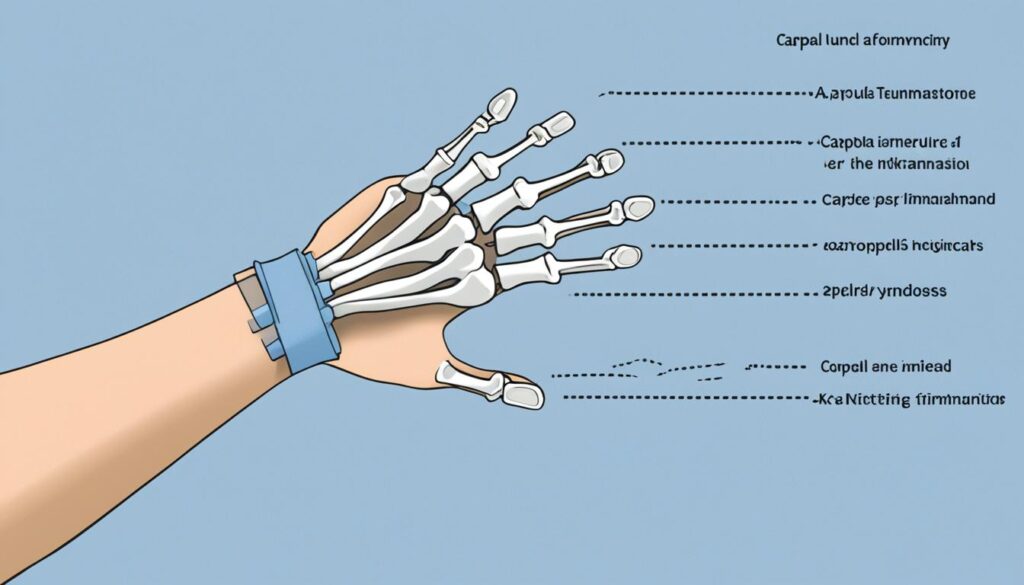Carpal tunnel syndrome is a prevalent condition that affects millions of Americans every year. However, it is not uncommon for this condition to be misdiagnosed. There are two conditions, in particular, that are often mistaken for carpal tunnel syndrome: rheumatoid arthritis and tendonitis. It is important to understand the symptoms and differences between these conditions to ensure an accurate diagnosis and appropriate treatment.
Key Takeaways:
- Rheumatoid arthritis and tendonitis are two conditions commonly misdiagnosed as carpal tunnel syndrome.
- Accurate diagnosis is crucial for providing proper treatment.
- Understanding the symptoms and differences between these conditions is essential.
- Carpal tunnel syndrome can be prevented with proper hand and wrist care.
- Treatment options for carpal tunnel syndrome range from conservative methods to surgery.
What is Carpal Tunnel Syndrome?
Carpal tunnel syndrome is a condition that occurs when the median nerve in the wrist becomes compressed and swollen. This compression leads to symptoms such as numbness, tingling, pain, and weakness in the hand. The median nerve is responsible for providing sensation to the thumb, index, middle, and ring fingers, as well as controlling some of the muscles in the hand.
The carpal tunnel is a narrow passageway in the wrist that protects the median nerve and the tendons that allow the fingers to bend. When the carpal tunnel becomes narrowed or there is swelling in the surrounding tissues, it can put pressure on the median nerve and cause the symptoms of carpal tunnel syndrome.
Common causes of carpal tunnel syndrome include repetitive hand and wrist movements, prolonged wrist flexion, and improper positioning of the hands during activities. It is also associated with certain medical conditions such as diabetes, arthritis, and thyroid disorders.
Symptoms of Carpal Tunnel Syndrome
The symptoms of carpal tunnel syndrome may vary from person to person, but common signs include:
- Numbness or tingling in the thumb, index, middle, and ring fingers
- Pain or discomfort that may radiate up the arm
- Weakness in the hand and a tendency to drop objects
- Difficulty with fine movements such as buttoning clothes or picking up small objects
If you are experiencing these symptoms, it is important to seek medical attention for an accurate diagnosis. A healthcare professional will typically perform a thorough physical exam to assess your symptoms, check for any physical signs of carpal tunnel syndrome, and evaluate your hand and wrist function.
In some cases, an electrodiagnostic study may be recommended to measure the electrical activity of the muscles and nerves in the hand. This can help confirm the diagnosis and determine the severity of the condition.
Early diagnosis and treatment are crucial for managing carpal tunnel syndrome and preventing further complications. Treatment options range from conservative measures such as wrist splinting, physical therapy, and medication to more invasive approaches like corticosteroid injections or surgery. The appropriate treatment plan will depend on the severity of your symptoms and the underlying cause of your carpal tunnel syndrome.
Carpal Tunnel Syndrome vs Rheumatoid Arthritis
Rheumatoid arthritis is a systemic disease that primarily affects the joints, including those in the wrist and hand. While carpal tunnel syndrome and rheumatoid arthritis share similar symptoms of discomfort, weakness, numbness, tingling, and reduced function in the wrists and hands, there are important differences that can help identify the correct diagnosis.
In addition to these shared symptoms, rheumatoid arthritis often presents with morning stiffness and joint pain in multiple parts of the body, reflecting its systemic nature. Fatigue and fever are also common symptoms associated with rheumatoid arthritis. In contrast, carpal tunnel syndrome primarily affects the fingers and palm side of the hand.
Proper differentiation between carpal tunnel syndrome and rheumatoid arthritis is crucial for accurate diagnosis and treatment. Rheumatoid arthritis is an autoimmune disease that requires a comprehensive management approach, including disease-modifying antirheumatic drugs (DMARDs) and physical therapy. On the other hand, carpal tunnel syndrome may be managed through conservative measures such as wrist splinting, activity modification, and occasionally corticosteroid injections. Surgical intervention may be recommended for severe or persistent carpal tunnel syndrome symptoms that do not respond to conservative treatments.
| Carpal Tunnel Syndrome | Rheumatoid Arthritis |
|---|---|
| Discomfort, weakness, numbness, tingling in wrists and hands | Discomfort, weakness, numbness, tingling in wrists and hands |
| Primarily affects fingers and palm side of the hand | Affects multiple joints in the body |
| No systemic symptoms | May present with morning stiffness, joint pain, fatigue, and fever |
| Can be managed through conservative measures | Requires comprehensive management with DMARDs and physical therapy |
| Surgery may be necessary in severe cases | Does not typically require surgical intervention |
Carpal Tunnel Syndrome vs Tendonitis
Tendonitis is another condition that can present with symptoms similar to carpal tunnel syndrome. Both conditions can cause pain, swelling, and limited range of motion in the hand and wrist. However, carpal tunnel syndrome primarily affects the fingers and palm side of the hand, while tendonitis typically involves localized pain near the affected tendon. Understanding the differences in symptom location can help in distinguishing between carpal tunnel syndrome and tendonitis.
To summarize:
| Carpal Tunnel Syndrome | Tendonitis |
|---|---|
| Primarily affects fingers and palm side of the hand | Localized pain near the affected tendon |
| May cause pain, swelling, and limited range of motion in the hand and wrist | May cause pain, swelling, and limited range of motion in the hand and wrist |
By carefully considering the specific symptoms and their location, healthcare professionals can make a more accurate diagnosis and determine the most appropriate treatment for individuals experiencing hand and wrist discomfort.
References:
- Carroll, L. (2021). Rheumatoid arthritis vs. carpal tunnel: What’s the difference? Medical News Today. Retrieved from [insert link]
- Mayo Clinic Staff. (2020). Tendinitis. Mayo Clinic. Retrieved from [insert link]
Common Activities that Cause Carpal Tunnel Syndrome
Carpal tunnel syndrome can be triggered by a variety of activities that involve repetitive hand and wrist motions. These activities put stress on the median nerve, leading to inflammation and swelling in the carpal tunnel. Here are some common activities that can contribute to the development of carpal tunnel syndrome:
- Typing and data entry
- Assembly line work
- Using vibrating power tools
- Participating in hand-intensive sports
- Performing forceful hand activities
Repetitive hand and wrist motions, such as typing on a keyboard or operating machinery, can cause the flexor tendons to rub against the carpal tunnel, resulting in irritation and compression of the median nerve. Prolonged wrist flexion and improper positioning of the hands and wrists can also increase the risk of carpal tunnel syndrome. Vibrating power tools and forceful hand activities, like hammering or gripping tools tightly, can further strain the wrist and contribute to the development of this condition. Additionally, hand-intensive sports that involve gripping or repetitive hand movements, such as tennis or cycling, can put stress on the carpal tunnel.
It is important to be aware of these activities and take necessary precautions to minimize the risk of developing carpal tunnel syndrome. Practicing proper ergonomics, taking regular breaks, and using wrist supports can help alleviate strain on the wrist and reduce the likelihood of developing this condition.

Tips to Prevent Carpal Tunnel Syndrome
Preventing carpal tunnel syndrome begins with making small changes in your daily routine and workspace. Here are some preventive measures that can help:
- Practice regular hand and wrist stretches to improve flexibility and relieve tension.
- Take frequent breaks during repetitive activities to allow your hands and wrists to rest.
- Ensure ergonomic positioning of your hands and wrists while using a keyboard or performing tasks.
- Use wrist splints to provide support and reduce strain on the wrist, especially during sleep.
- Consider modifying your workspace by using ergonomic equipment, such as an adjustable keyboard or chair.
By implementing these preventive measures, you can reduce the risk of developing carpal tunnel syndrome and maintain the health of your hands and wrists.
How to Prevent Carpal Tunnel Syndrome
Carpal tunnel syndrome is a common condition that can be debilitating if left untreated. While it may not be possible to completely prevent carpal tunnel syndrome, there are several preventive measures you can take to reduce the risk of its development and progression.
Hand and Wrist Stretches
Performing hand and wrist stretches regularly can help keep your hand and wrist muscles flexible and reduce strain. Simple exercises such as wrist flexion and extension, finger stretches, and wrist circles can help improve circulation and prevent muscle imbalances.
Frequent Breaks
Take frequent breaks during repetitive activities that involve prolonged use of your hands and wrists. This allows your muscles and tendons to rest and recover, reducing the risk of overuse injuries. Stand up, stretch, and give your hands a break every 30 minutes to an hour.
Ergonomic Hand and Wrist Positions
Ensure that you maintain proper ergonomic hand and wrist positions when performing tasks such as typing or using a mouse. Your wrists should be in a neutral position, not bent upwards or downwards. Invest in an ergonomic keyboard and mouse that promote a natural hand and wrist alignment.
Wrist Splints
Consider wearing wrist splints, especially at night, to keep your wrists in a neutral position and relieve pressure on the median nerve. Wrist splints can be particularly beneficial if you frequently wake up with numbness or tingling in your hands.
Surgery
In more severe cases of carpal tunnel syndrome, surgery may be necessary. Carpal tunnel release surgery aims to relieve pressure on the median nerve by cutting the ligament that forms the roof of the carpal tunnel. It is typically recommended when other conservative treatments have failed to provide relief.
Preventing carpal tunnel syndrome requires a combination of awareness, proper ergonomics, and self-care. By incorporating hand and wrist stretches into your routine, taking regular breaks, maintaining ergonomic positions, considering the use of wrist splints, and exploring surgical options when necessary, you can reduce the risk of carpal tunnel syndrome and maintain optimal hand and wrist health.
Treatment Options for Carpal Tunnel Syndrome
When it comes to treating carpal tunnel syndrome, the approach taken depends on the severity of the condition. In mild to moderate cases, conservative methods are often recommended as the first line of treatment. These methods include:
- Nonsteroidal Anti-Inflammatories: These medications help reduce inflammation and relieve pain associated with carpal tunnel syndrome. They can be taken orally or applied topically as a cream or gel.
- Corticosteroid Injections: In some cases, corticosteroid injections may be recommended to reduce inflammation and provide temporary relief from symptoms. These injections are typically administered directly into the carpal tunnel.
- Wrist Splinting: Wearing a wrist splint can help provide support and immobilize the wrist, reducing pressure on the median nerve. Splints are often worn at night but may also be used during the day, especially during activities that may exacerbate symptoms.
If conservative methods do not effectively alleviate symptoms or if the condition worsens, surgery may be considered. There are two main surgical approaches:
Open Release: This traditional surgical technique involves cutting the carpal ligament to increase the size of the carpal tunnel and relieve pressure on the median nerve.
Endoscopy: An endoscopic procedure involves the use of a small camera and specialized tools to cut the carpal ligament through small incisions. This minimally invasive technique may offer a quicker recovery and smaller scars compared to open release surgery.
The decision to undergo surgery should be made in consultation with a specialist, taking into consideration the specific benefits and risks associated with each approach.

| Treatment Option | Method | Benefits | Risks |
|---|---|---|---|
| Nonsteroidal Anti-Inflammatories | Oral or Topical Medication | – Reduces inflammation and pain – Convenient and accessible |
– Potential side effects – May not provide long-term relief |
| Corticosteroid Injections | Intra-articular Injection | – Reduces inflammation and symptoms – Provides temporary relief |
– Risk of infection or tendon rupture – Temporary pain at injection site |
| Wrist Splinting | Immobilization | – Provides support and relieves pressure – Convenient and non-invasive |
– May restrict hand movement – Potential discomfort or skin irritation |
| Open Release Surgery | Traditional Approach | – Provides long-term relief for severe cases – Increases carpal tunnel size |
– Longer recovery time – Potential complications |
| Endoscopic Surgery | Minimally Invasive Approach | – Quicker recovery time – Smaller scars |
– Risk of nerve or blood vessel damage – Potential complications |
Conditions That Are Frequently Misdiagnosed As Carpal Tunnel Syndrome
In addition to rheumatoid arthritis and tendonitis, there are several other conditions that can be misdiagnosed as carpal tunnel syndrome. These conditions often present with similar symptoms, leading to confusion and potential mismanagement if not accurately diagnosed. It is crucial to seek an accurate diagnosis to ensure the appropriate treatment for these conditions.
Arthritis
Arthritis, a common condition that causes joint inflammation, can mimic the symptoms of carpal tunnel syndrome. The pain, stiffness, and reduced range of motion in the wrist can be mistaken for carpal tunnel syndrome symptoms. However, arthritis affects multiple joints, whereas carpal tunnel syndrome primarily affects the wrists and hands.
Wrist Flexor Tendonitis
Wrist flexor tendonitis, also known as tenosynovitis, is the inflammation of the tendons in the wrist responsible for flexing the fingers. This condition shares symptoms like pain, swelling, and limited mobility with carpal tunnel syndrome. However, the pain in wrist flexor tendonitis is typically localized near the affected tendons, differentiating it from the more diffuse pain of carpal tunnel syndrome.
Pinched Nerves
Pinched nerves, particularly in the cervical spine or upper limbs, can cause symptoms similar to carpal tunnel syndrome. Nerve compression can lead to pain, weakness, numbness, and tingling sensations in the hand and wrist region. Differentiating between carpal tunnel syndrome and pinched nerves requires a thorough examination to identify the source of nerve compression.
Ligament Damage
Ligament damage in the wrist can result from injuries or repetitive stress. This can lead to symptoms resembling those of carpal tunnel syndrome, such as pain, weakness, and limited hand function. However, ligament damage often presents with instability or abnormal joint movement, which is not typically observed in carpal tunnel syndrome.
Neuropathy
Neuropathy refers to nerve damage, which can cause symptoms similar to carpal tunnel syndrome. Numbness, tingling, pain, and muscle weakness can occur in both conditions. However, neuropathy may involve sensory changes in locations beyond the wrist and hand, whereas carpal tunnel syndrome affects specific areas supplied by the median nerve.
It is important to consult with a healthcare professional to accurately diagnose these conditions and determine the appropriate course of treatment.
Conclusion
In conclusion, managing carpal tunnel syndrome requires an accurate diagnosis and appropriate treatment. While carpal tunnel syndrome can be easily misdiagnosed due to similar symptoms shared with other conditions like rheumatoid arthritis and tendonitis, understanding the differences is crucial to ensure the right course of action. Moreover, prevention plays a crucial role in mitigating the risk of carpal tunnel syndrome.
By incorporating preventive measures such as regular hand and wrist stretches, taking frequent breaks, and maintaining ergonomic positions, individuals can reduce the likelihood of developing carpal tunnel syndrome. However, if diagnosed with carpal tunnel syndrome, there are various treatment options available. Conservative methods like nonsteroidal anti-inflammatories, corticosteroid injections, and wrist splinting are effective for mild to moderate cases.
For severe or persistent cases, surgical intervention may be necessary. Open release and endoscopy are two common surgical approaches that aim to alleviate pressure on the median nerve. When navigating treatment options, it is essential to consult with a specialist to weigh the benefits and risks associated with each approach. By embracing accurate diagnosis, appropriate treatment, and prevention, individuals can actively manage carpal tunnel syndrome and improve their quality of life.
